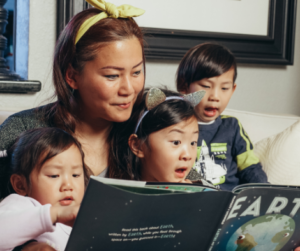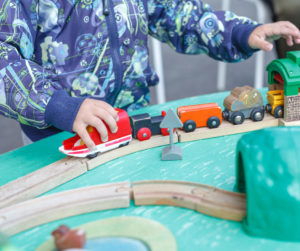Today, families are choosing to homeschool in all kinds of ways. Some families figure out having a stay-at-home parent, some homeschool while working from home, and some find a way to homeschool while working outside the home. Let’s take a look at what a kindergartener’s day might look like in each of these different situations.
Stay At Home Parent
 This is the historically most common way to homeschool, so there are a lot of resources about this method. A parent, usually the mom, but not always, stays home with the kids. This parent makes breakfast, lunch, and snacks during the day while the other parent is at work. The homeschool week often includes an hour each day of doing a curriculum and then has time each afternoon for outings to the park, library, and other places.
This is the historically most common way to homeschool, so there are a lot of resources about this method. A parent, usually the mom, but not always, stays home with the kids. This parent makes breakfast, lunch, and snacks during the day while the other parent is at work. The homeschool week often includes an hour each day of doing a curriculum and then has time each afternoon for outings to the park, library, and other places.
Kindergarten is just a continuation of what this child was doing before with their stay-at-home parent with a little more structure. Some parents find that they like having lessons in the morning and others prefer the afternoon, but either way, the homeschooling part of the day doesn’t take the whole day. This means parents need to find ways to help their children fill more of their day. This could be filled with playing, making art, going on walks, or many other things. It is often helpful to join a co-op or find a mother’s group so you can set up playdates.
The downside of this option is that stay-at-home parents often feel isolated, and kids can get lonely. That is why I recommend finding a co-op or playgroup. Even just a single friend that you do a weekly playdate with can help break up the week. You can also plan for short, easy, and fun lessons to do together if that helps your play dates feel more official.
Work From Home
Working from home means you need to put in more planning for what your child will do. You can’t throw cranky kids in the car to go to the park on a whim, so you have to find a rhythm that works for all of you.
 Setting up a morning basket or invitation to play that your child will find in the morning is one way to keep your child busy after breakfast. A morning basket can be an actual basket your child goes to to find what they should work on for the morning. While this basket could be many things for many ages, for a kindergarten child it could include a coloring sheet, a no-mess watercolor page, a puzzle to work on, and picture books to look at. I am also a fan of having cutting activities so your child learns to use scissors and pages that teach them to trace shapes.
Setting up a morning basket or invitation to play that your child will find in the morning is one way to keep your child busy after breakfast. A morning basket can be an actual basket your child goes to to find what they should work on for the morning. While this basket could be many things for many ages, for a kindergarten child it could include a coloring sheet, a no-mess watercolor page, a puzzle to work on, and picture books to look at. I am also a fan of having cutting activities so your child learns to use scissors and pages that teach them to trace shapes.
An invitation to play is just that, a setup that helps your child get started playing alone. You could set up their train tracks on the coffee table with a few trains. You could lay out their doll house and put inside it some tiny foods, like blueberries for the dolls to eat today. You could pull out their blocks and build half of a castle for them to finish. Doing those things while your child sleeps means they wake up with something calling them to come play with it.
For my children, I would probably have needed to have both the play invitation for first thing and the basket to send them to once they were played out.
You can also plan to read them a picture book during lunch. If you are lucky, you can also plan to work outside and let your child go play there for a while each day.
I do recommend keeping screen time to a set schedule. Perhaps your child will no longer nap, but isn’t good at taking a break, and tends to get cranky in the afternoon, making it hard to work. This is a good time to let them have an hour of educational TV. They can lie down and rest while watching Bluey or something on PBS Kids. These shows are age-appropriate and can inspire your child to participate in more educational play when their rest time is done.
As far as curriculum goes, your child can work on learning activities with you during a few-minute break each day, or after your work day is over. This is a good time to introduce a new idea or a letter to write, and then it can appear again in tomorrow’s morning basket.
Work-at-home parents who can take breaks may be able to put their children in co-ops or other classes and work while the kids participate. However, some co-ops require parental participation, so ask lots of questions about what is expected of you before joining.
Working while homeschooling is actually really challenging. Don’t let anyone tell you this is an easy choice. You will need to put in a lot of effort to keep your child occupied while you work. My kids never got bored, they just got into trouble when I was busy. Lots of planning ahead is what this lifestyle choice requires.
Work Out of the Home Parents
 If you are working out of the home, childcare is possibly your biggest challenge. I firmly believe that kindergarten doesn’t have to be elaborate and you can work with your child on the weekends to learn letters, numbers, shapes, and colors. You will need to figure out how to do that and how to work in a few minutes a day of fun, educational activities. Things like reading bedtime stories that go with your theme of the week can really help you pull your child’s learning together.
If you are working out of the home, childcare is possibly your biggest challenge. I firmly believe that kindergarten doesn’t have to be elaborate and you can work with your child on the weekends to learn letters, numbers, shapes, and colors. You will need to figure out how to do that and how to work in a few minutes a day of fun, educational activities. Things like reading bedtime stories that go with your theme of the week can really help you pull your child’s learning together.
If you do need to work outside the home and put your child into a care situation, be sure your child care aligns with your parenting and educational goals. It is great if you want to let your child wait a bit to learn to read and write, but if your childcare provider is pushing reading or writing, your child may develop some bad habits. A completely play-based program may be better than an academic one unless you are on the same page about what you want for your child.
Some preschools and daycares have become very academic. I am not a fan. The research on child development says that these programs do more harm than good in the long term. So, choose carefully. If you have a family member who will love your child, play with them, and bake cookies with them, that is better for their long-term development than a preschool that is pushing reading and writing.
It will be okay
Whatever you choose, remember that kindergarten should be fun. Homeschooling isn’t easy, but it also shouldn’t be miserable for either you or your child. If it feels like it isn’t working, ask for advice, and try something else. Life is too short to be miserable.





0 Comments